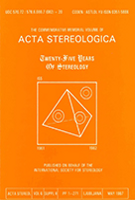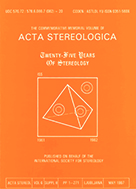- Home
- Volume 12 (1993)
- Number 2 - Proceedings of the sixth European congr...
- Second-order stereology of prostatic adenocarcinoma and normal prostatic tissue
View(s): 522 (1 ULiège)
Download(s): 249 (1 ULiège)
Second-order stereology of prostatic adenocarcinoma and normal prostatic tissue

Abstract
The spatial arrangement of the epithelial tissue component was studied in prostatic cancer and in normal prostatic tissue by applying second-order stereological methods to histological sections from 20 prostatectomy specimens. Interactive segmentation of the epithelial tissue component in normal and neoplastic tissue was performed with an image analyzer. The epithelial component was considered as a stationary isotropic ergodic random closed set with positive volume fraction Vv (volume process). The covariance C(r) of a volume process is the probability that two points in the reference space, separated by a line of length r, hit the process simultaneously. An unbiased estimate Ĉ(r) of the covariance of the epithelial volume component was obtained automatically from the stored images. From Ĉ(r) and the estimated volume density Vv, consistent estimates of the correlation function k(r), of the pair correlation function g(r), of the radial distribution function RDF(r) and of the reduced second moment function K(r) of epithelial volume were determined. Estimation of C(r) and RDF(r) alone did not permit a distinction between different types of spatial arrangement of epithelium in benign and malignant tissue. Estimation of k(r), g(r) and K(r) showed clustering of epithelial volume at short distances and repulsion at long distances. The best discrimination between benign and malignant tissue was obtained by estimation of g(r). The pair correlation function indicated a partial loss of epithelial interaction in the carcinomatous tissue, which was more pronounced in cribriform than in acinar adenocarcinomas. Second-order stereology reproducibly detects architectural changes in malignant lesions of glandular organs, with g(r) serving as the most useful tool.






